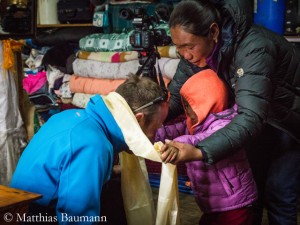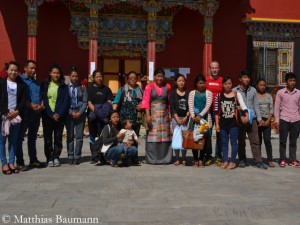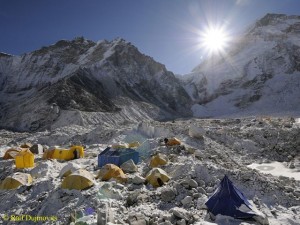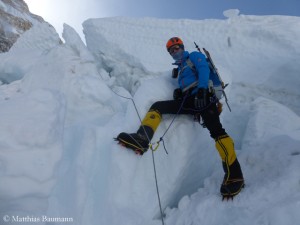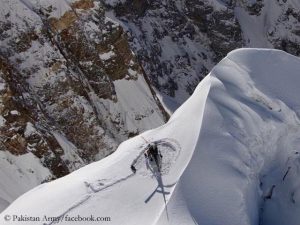Baumann: “Families of Everest victims still need help”
There was no climbing on Mount Everest on this Saturday. At the Base Camp at 5,300 meters, more than 300 western climbers and an equivalent number of Sherpas commemorated the 16 Nepalis who had been killed in the avalanche in Khumbu Icefall exactly one year ago. It was the worst avalanche disaster in the history of Everest. The German climber and physician Matthias Baumann had witnessed the tragedy at the Base Camp. Later he visited the families of the victims and launched a relief campaign for them. In March, the 43-year-old trauma surgeon from the city of Tuebingen traveled again to Nepal. He distributed money to the families of the victims and launched financial sponsorships to guarantee the education of the avalanche victims’ children.
Matthias, a year ago, you were at the Base Camp of Mount Everest, when the avalanche released in the Khumbu Icefall. You were among the doctors who first treated the injured climbers. Are you still thinking of what happened on 18 April 2014?
In recent days and of course especially today on the anniversary, I’ve been thinking of it again. I’m not traumatized because I am daily facing suffering in my job as a trauma surgeon. But it moves me emotionally, on the one hand because of my own passion for mountaineering, on the other hand because the avalanche victims were Sherpas, whom I do appreciate anyway.
You’ve collected a total of 100,000 Euros for the families of the avalanche victims and you were just now in Nepal to distribute the donated money. How are the families today?
My impression is that they have regained stability again, but not completely. When I visited them, most women of avalanche victims burst into tears. That was not the case last year – maybe because they were still in shock, maybe because they wanted to show strength in the presence of their children. This time it was much more emotional.
The families lost their breadwinners. Do they make ends meet?
It’s difficult. As always in such a case in Nepal, other relatives have to help. Women in the mountain areas have almost no chance to make money. In Kathmandu, that works a bit better. The Nepalese government increased its emergency aid for the families from 400 to 5,000 US dollars and handed over the money. Some expedition operators which had employed the Sherpas who died in the avalanche, for instance Alpine Ascents International, gave money too. Therefore the families are not fully dependent on themselves. But I got the impression that they still do need help.
In Khumbu, I also donated money to a Sherpa family whose breadwinner died on Everest in 2012 [Namgyal Tshering Sherpa fell into a crevasse near Camp 1]. This family had received only the emergency aid which was usual then, means $ 400, nothing else. That was brutal. After all, last year’s avalanche disaster draw a little attention to the fate of the Sherpa families that lost relatives on Everest.
Did you feel that the atmosphere within the Sherpa community has changed due to the avalanche incident?
Definitely. There were these different groups among the Sherpas. We saw that in the attack against Simone Moro and Ueli Steck in 2013. And last year I experienced myself how aggressive a small group of Sherpas was, while the majority actually wanted to continue climbing. I got the impression that after the avalanche disaster Sherpas have moved closer together again. There was a small positive effect, even if not all the demands of the Sherpas have been met.
Currently, again more than 300 foreign climbers are at the Base Camp on the Nepalese side of Everest. Is it business as usual?
I think, actually the number of climbers should be reduced. But this is a double-edged sword. On the other hand so many income opportunities for local people are connected with climbing on Everest. Therefore, there is largely business as usual again, except for the fact that the permits cost additional $ 1,000 each [The price for an Everest permit is now $ 11,000 per person, regardless of the number of expedition members] and that the additional revenue is to go into a relief fund. In addition, the route through the icefall was relocated to some extent. But everything else remains the same.
The Nepalese government has decided that the permits from 2014 remain valid to 2019. That goes for you, too. What’s about your plan to try Everest again?
Dreams do not disappear, nor does the passion for climbing. For me, it was not possible this year because I changed my job. I would have preferred the north side of Everest, because there are now so many German high altitude mountaineers. That would have interested me as a physician too, because many of them want to climb up without bottled oxygen. Honestly, I really would have liked to join them.
Would you return to Everest with a different feeling?
I always felt personally connected to the Sherpa people. But after the experience of 2014, I have even more respect for them and their performance. For me, they are the true heroes on Everest.
It seems to me that many other climbers on Everest don’t show this kind of respect.
I think so too. Many see the Sherpas only as unskilled workers. Instead many of them are better climbers than the majority of the western Everest aspirants. This makes it much more interesting when you’re out with them. I do respect the Sherpas at eye level, and they realize me doing it this way. They tell me a lot about their culture, and we have lots of fun together. This is a real enrichment for me. Sometimes respect is greater than money.
P.S. Matthias continues collecting donations for the families of Sherpas who died in the Himalayas.



